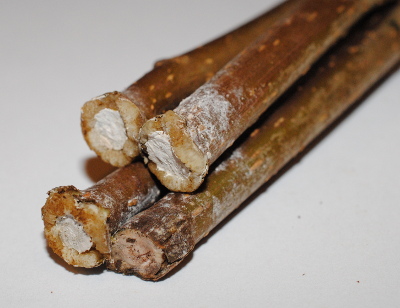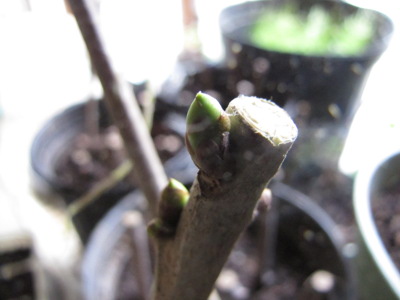
Illinois everbearing mulberry rooting
 I sent some Illinois
everbearing mulberry cuttings to a reader who wanted to experiment with
their propagation, and asked that he give me some details on how his
experiments panned out. Last week, Gary wrote back to tell me:
I sent some Illinois
everbearing mulberry cuttings to a reader who wanted to experiment with
their propagation, and asked that he give me some details on how his
experiments panned out. Last week, Gary wrote back to tell me:
"My second approach was to dip in rooting hormone, wrap in moist newspaper, roll in a black plastic bag and place over a furnace register. A similar approach that I use successfully for grape vine cuttings. On inspection last night I have callus starting to form on three of the four I.E. Mulberry cuttings using this method. [See photo above.] They are still a few days to a week away from planting in a rooting medium but I am encouraged by good callus formation.
"I'll share another update in a month or so with updates on rooting and with early results from my grafting efforts."
 As
a side note, I decided to try my own mulberry experiments at the same
time I sent cuttings to Gary. I soaked them in willow
rooting hormone for
a day, then put four cuttings in a pot inside and about a dozen
straight into the ground outside.
As
a side note, I decided to try my own mulberry experiments at the same
time I sent cuttings to Gary. I soaked them in willow
rooting hormone for
a day, then put four cuttings in a pot inside and about a dozen
straight into the ground outside.
As you can see, one of
the cuttings inside is breaking dormancy already, which is actually a
bad thing since that
cutting shows no signs of growing roots. On the other hand, a
differnt one of the four indoor mulberry cuttings and perhaps three of
the outdoor mulberry cuttings show some resistance to the tug test,
suggesting they might be growing roots. I'll post again when the
time comes to repot and I know what kind of root growth (if any) comes
from my simple propagation method.
Want more in-depth information? Browse through our books.
Or explore more posts by date or by subject.
About us: Anna Hess and Mark Hamilton spent over a decade living self-sufficiently in the mountains of Virginia before moving north to start over from scratch in the foothills of Ohio. They've experimented with permaculture, no-till gardening, trailersteading, home-based microbusinesses and much more, writing about their adventures in both blogs and books.
Want to be notified when new comments are posted on this page? Click on the RSS button after you add a comment to subscribe to the comment feed, or simply check the box beside "email replies to me" while writing your comment.

Isn't it possible to root live existing branches off of trees with rooting hormone and then cutting the rooted branches from the main structure? If so, what do you think the benefit is of cutting branches clean and rooting them this way?
"Check out my Survivalist Blog at the Clever Survivalist and read daily Survival Guide content."
Derek --- My next update will come around the frost-free date (mid-May) when I set out the ones I have in pots and get a look at their roots (or lack thereof). I suspect I'll hear from our reader around then too.
I don't have any data on hardiness of ungrafted Illinois everbearing, but since they're simply a hybrid of red and white, I'd suspect they'd be just as hardy. The species that is less hardy (although supposedly more delicious) is the black mulberry, which I've yet to try.
http://www.starkbros.com/products/fruit-trees/additional-fruit-trees/illinois-everbearing-mulberry
I contacted Starkbros directly via email about this. Here is their response...
Dear Derek,
Our Illinois Everbearing Mulberry is from a rooted cutting rather than a graft.
I hope this has been helpful!
This is worth watching if you are interested in air layering, I bet these would work great to make a few new mulberries, like stated above, it wouldnt be practical for creating large amounts of trees.
http://www.mikesbackyardnursery.com/2012/05/clam-shell-air-propagator/
http://www.airpropagator.com/buy_online.php On sale even...